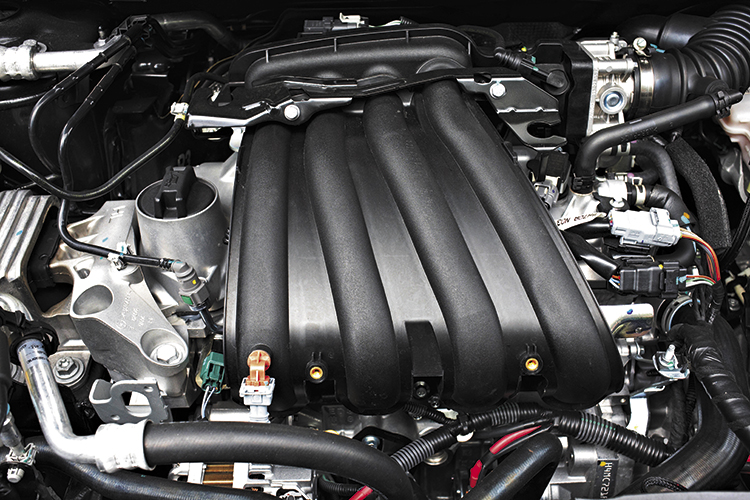
Carmakers must satisfy a number of criteria when creating names for their new models. Ideally, a moniker should reflect the type of vehicle it is, sound nice and be marketable.
Whether or not the name is a “good” one can be debated to no end. But if a car’s name can make people recall its design whenever they hear it, that puts it a step ahead of its rivals.

The Renault Fluence’s cabin layout is shared with the Megane hatchback.
Consider “Fluence”, for instance – it immediately evokes feelings of fluidity. The car’s headlamps, which are swept back for a sleeker face, blend nicely into the front fender. A continuous shoulder line runs the length of the sides and even around the high-ish boot, adding to the impression of length.
The tail lights, which mirror the shape of the headlights, top off the Fluence’s cohesive form.

Not all the exterior’s fluidity, however, is carried into the Fluence’s cabin. The standard Carminat TomTom navigation device, for instance, could have a more intuitive interface. Using the device’s remote control to input your destination into the system can be time-consuming, especially if you’re in a hurry.
The good news is that the remote itself only has a few buttons, which makes using it somewhat less complicated to use.

Also making up for this is the fact that apart from being able to choose from a variety of English accents (Irish, British and American, to name a few) as well as a male or female voice, the navigation system also gives directions in Hokkien and Cantonese. Talk about local flavour.
As an added safety bonus, the TomTom system can be synced to your mobile phone via Bluetooth, eliminating the need to carry around a headset.

You’ll be able to make and answer phone calls in the Renault Fluence once you find these switches.
Getting your phone synced, however, takes a bit of fiddling as the buttons for doing this are found behind the right side of the steering wheel. A more unified and conveniently located set of controls would have made using the system a lot smoother.
Aside from those two issues, the cabin is a pleasant place. The “latte” coloured upholstery seen here is a welcome break from the usual beige and black options offered by most rivals.

Renault Fluence’s backseat has an almost-flat rear floor for enhanced legroom, but taller passengers will need more headroom.
You get chrome-ringed analogue instrument meters instead of the part-digital setup found in the Megane hatch. Keeping the tropical heat at bay is the air-conditioning, which is quite cold even when the system is set to 24 degrees.
With a wheelbase length of 2702mm, the Fluence’s rear bench offers a generous amount of legroom and is also wide enough to comfortably accommodate three adults.

Because the bench is set a bit high, however, taller occupants should take care not to bump their temples along the edges of the cabin ceiling.
Passengers aside, the Fluence is also adept at taking on luggage thanks to its massive 530-litre boot, which can swallow up to three golf bags. Fitting longer items isn’t a problem either, as the rear seats can be split-folded with a simple press of a button.

Though the interior is not as “fluid” as expected, the car certainly makes up for this with the way it drives. True to its moniker, the Fluence boasts a supple ride that glosses over bumps and makes occupants feel as if the undulations were never there to begin with.
Despite the softer suspension setting, body roll is still kept in check, enabling the Fluence to corner with typical French poise.

It would take a bend tighter than this to ruffle the Renault Fluence’s suspension.
For better control, the Fluence’s helm provides more assistance at low speeds to ensure parking manoeuvres can be performed with minimal effort, while tightening up at cruising speeds to give the driver a more stable feel. The brakes are progressive in the sense that they work harder the more firmly the pedal is depressed, but they could still do with more initial bite.
Developed in conjunction with alliance partner Nissan, the 112bhp 1.6-litre engine is a quiet performer with ample power for most needs. This motor is paired with a “6-speed” CVT (which was also developed with Nissan), which remains buttery even when stretched.

Flooring the throttle, however, will cause the CVT to emit a long drone while exhibiting a palpable “clutch slip” sensation. At any rate, the car is at its best when driven at a normal instead of frantic pace.
Priced at $98,888, the Fluence clearly has everyone’s favourite family saloon, the Toyota Corolla Altis, in its sights.

Notwithstanding some convenience issues with the TomTom system, the Fluence combines a roomy cabin with a better ride compared to its rivals.
Add six airbags, a distinctive design and competitive pricing to the mix, and you’ve got a car that just might influence those looking for a 1.6-litre family saloon to select this alternative choice.

You can’t tell from the outside, but the Renault Fluence has a 530-litre boot.
Renault Fluence 1.6 (A)
ENGINE 1598cc, 16-valves, inline-4
MAX POWER 112bhp at 6000rpm
MAX TORQUE 156Nm at 4400rpm
GEARBOX CVT with 6-speed override
0-100KM/H 11 seconds
TOP SPEED 185km/h
CONSUMPTION 13.2km/L
PRICE INCL. COE $98,888 (as of January 2011)
Check out the Renault Fluence’s successor, the Renault Megane Sedan
Group Test: Renault Megane Sedan Privilege 1.5 vs Volkswagen Jetta Sportline 1.4












